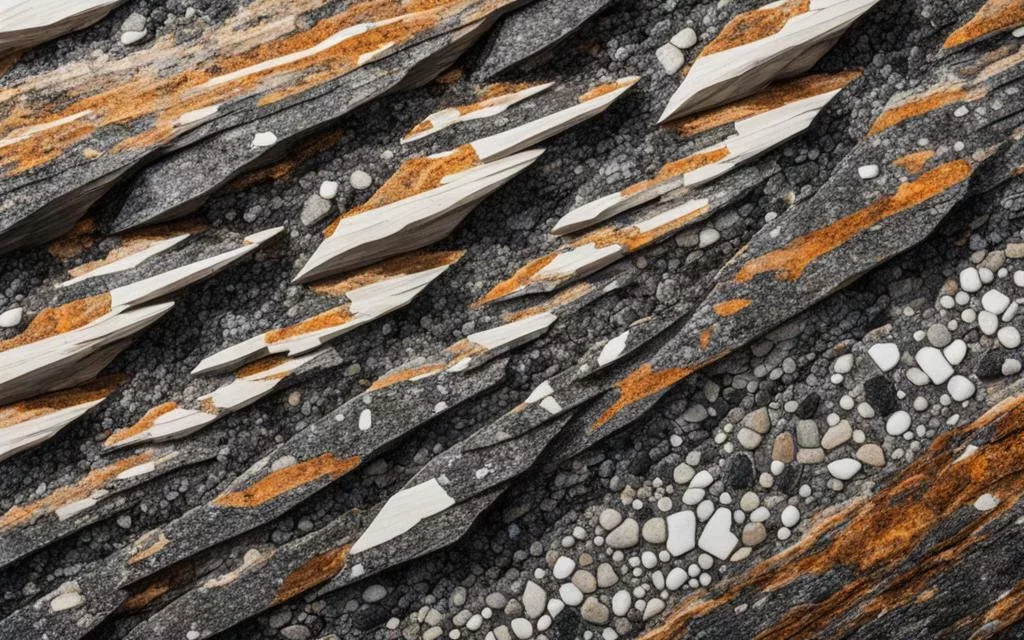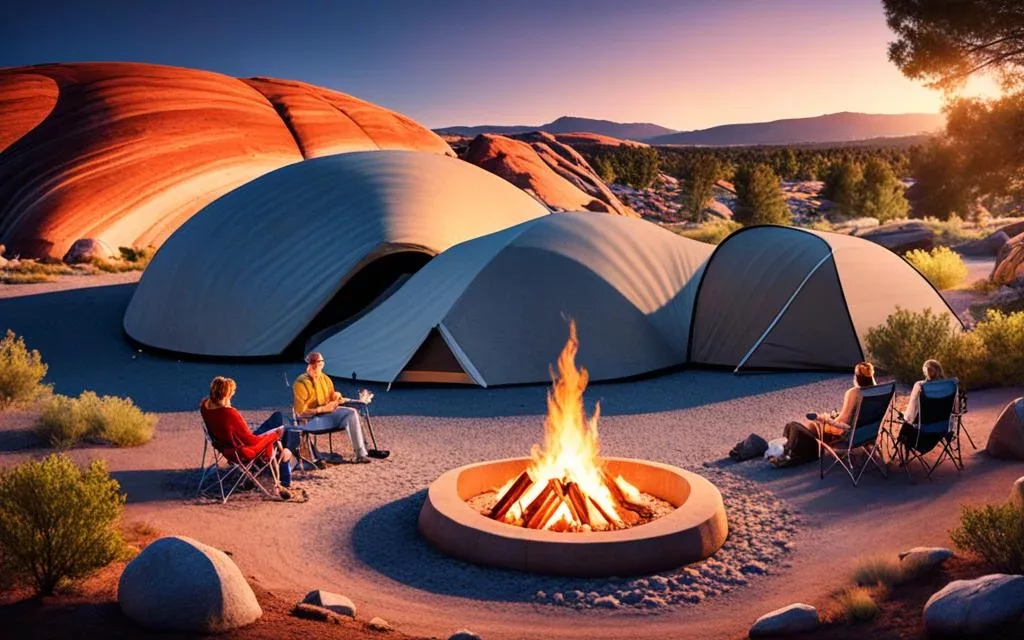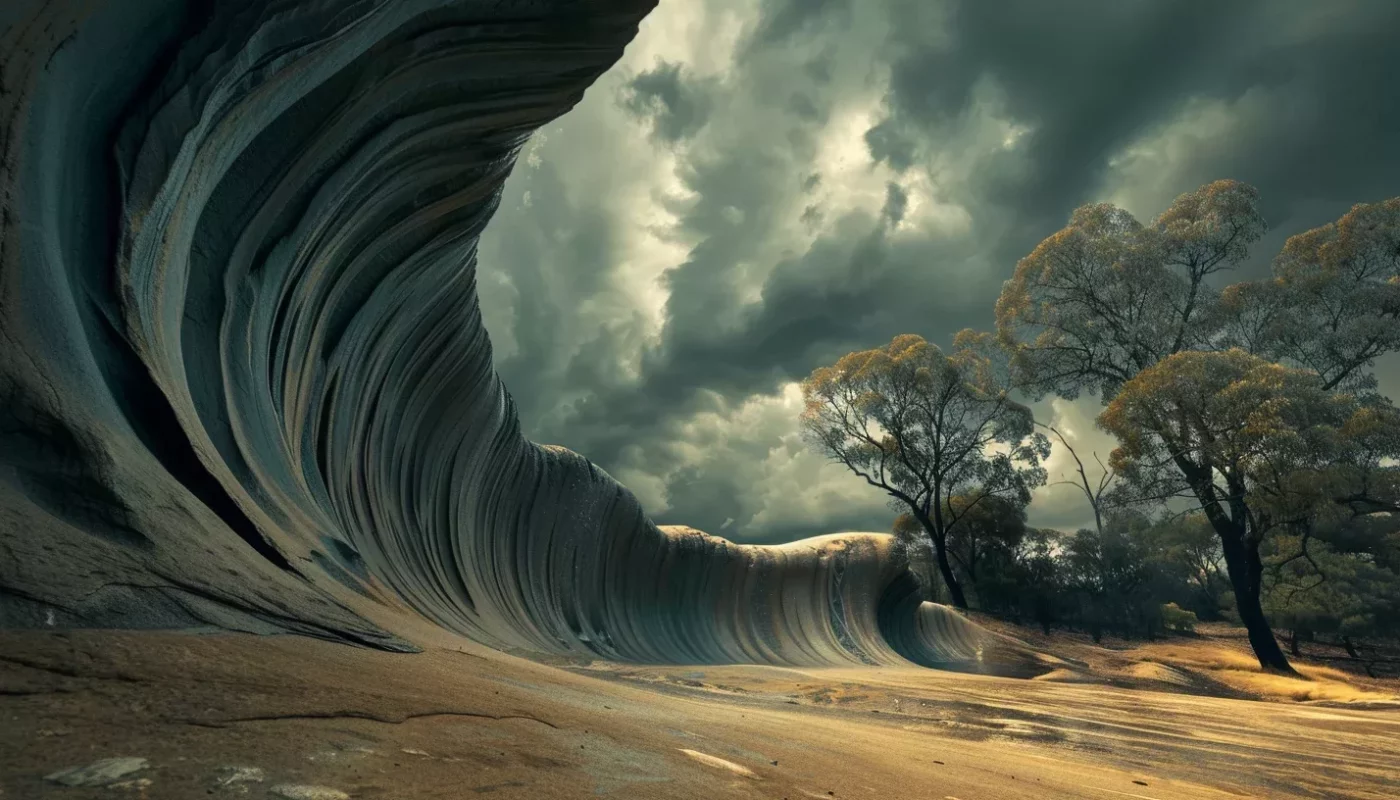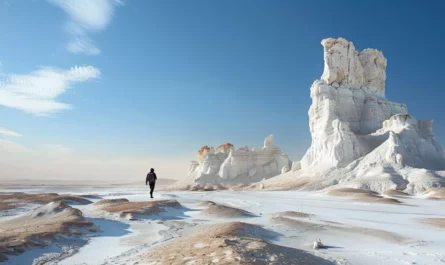Did you know Wave Rock draws over 100,000 visitors each year? It’s a stunning granite wave in Western Australia. This creation is part of Hyden Wildlife Park, standing 15 meters high and stretching 110 meters long. It’s a major natural landmark and key part of Australia’s geology.
Visitors are amazed by this granite rock, which shows the area’s beauty and ancient history. It offers a peek into the earth’s deep past. But, as more people visit, protecting this place is key. We need to save its beauty and meaning for others to see in the future.
The Natural Marvel of Wave Rock
Wave Rock stands out as a stunning natural wonder in Western Australia. With its unique wave shape, this granite rock awes everyone who sees it.
Location and Coordinates
You can find it 3 km east of Hyden and 296 km from Perth. Its exact location is 32°26′38″S 118°53′54″E. Anyone touring Western Australia should definitely check it out.
Dimensions and Physical Features
Wave Rock towers at about 15 meters and runs for 110 meters. This wave-like rock was formed from granite over millions of years. Weathering and erosion played a big part in its shape.
It’s part of Hyden Rock, which includes three connected domes. These domes form low platforms that add to its charm. An old water collection system here also points to clever engineering from the past.
A Geological Wonder
Wave Rock astonishes us with formations from the ancient Yilgarn Craton, one of Earth’s most ancient continental pieces. Its composition includes biotite K-feldspar porphyritic monzogranite. This gives Wave Rock a special texture and strength that draws both scientists and visitors.

About 100 to 130 million years ago, in the Cretaceous Period, granite rock changed a lot under the ground. This happened beneath a lateritized land surface. The weathering during the Cretaceous was key in making the rock look how it does today.
Formation Process
The way Wave Rock formed shows how nature works hard over time. The biotite K-feldspar porphyritic monzogranite was deeply altered by chemical processes from groundwater. When the land above wore away over many years, these altered rocks appeared.
Flared Slope Structure
Wave Rock’s ‘flared slopes’ are a key geological feature. These unique shapes form at the bases of inselbergs due to groundwater weathering. They show us amazing formations after the top layers have worn away, teaching us about ancient Earth’s geology.
It’s very important to keep these geological formations safe. To ensure Wave Rock stays wonderful for people in the future, there are local and government efforts to protect it.
Wave Rock’s Cultural and Dreamtime Significance
Wave Rock, known to the Ballardong people as Katter Kich, is more than a natural wonder. It is also a precious Aboriginal heritage site. The area is filled with Dreamtime stories handed down for generations. One of the key legends involves the Rainbow Serpent.
Ballardong People’s Heritage
The Ballardong people have lived near Wave Rock for a long time. They see it as an essential cultural and spiritual center. Called Katter Kich, this place ties them to their land and traditions. Many Dreamtime stories talk about Wave Rock’s creation, often involving the Rainbow Serpent.
The Legend of the Rainbow Serpent
The Rainbow Serpent plays a big role in the Ballardong’s stories. According to these stories, the serpent shaped the land, making rivers and rocks. Wave Rock is one such creation. These tales show how closely the Ballardong people connect with their environment. They help us understand the rock’s deep cultural meaning among Aboriginal heritage sites.
Wave Rock is a key part of a larger Dreamtime trail. This trail goes from the south coast to the Great Victoria Desert. Places like Mulka’s Cave and Dumbleyung Lake add to the region’s stories. This adds layers of cultural knowledge in the Ballardong area.
Other Wave-Shaped Rock Formations in Western Australia
Western Australia is famous for its unique granite landforms. Among them, Elachbutting Rock and Beringbooding Rock are notable. They have wave-like features, much like the well-known Wave Rock.
Elachbutting Rock
Elachbutting Rock is about 100 km northeast of Mukinbudin. It has a striking wave-like shape. Though it might not be as big as Wave Rock, it has its own special look.
Visitors find its dramatic curves and detailed rock textures fascinating. These show the natural erosion that creates such landforms.
Beringbooding Rock
Just a short distance from Elachbutting Rock is Beringbooding Rock. It features a young wave-shaped overhang by a waterhole. This shows it could grow into a wave form over millions of years, adding to the area’s natural wonders.
Visiting Beringbooding Rock lets people see the geological marvels of the region. It’s a glimpse into the area’s rich natural history.
It’s crucial to conserve these stunning granite formations. Keeping Elachbutting and Beringbooding Rocks safe lets future visitors enjoy them too. Efforts are underway to protect these spots from natural and human damage. This helps ensure sustainable tourism.
| Rock Formation | Location | Key Features |
|---|---|---|
| Elachbutting Rock | 100 km northeast of Mukinbudin | Wave-like structure, dramatic curves |
| Beringbooding Rock | Near Elachbutting Rock | Wave-shaped overhang, waterhole |
Visitor Information and Nearby Attractions
Wave Rock offers many amenities for all kinds of visitors. It has accessible parking and scenic picnic areas. This makes sure everyone has a fun visit. The walking trails let you deeply explore nature, surrounded by beautiful trees.

Access and Amenities
Getting to Wave Rock is easy, thanks to the good roads from Hyden. There is plenty of parking and great spots for picnics. Adventure lovers will find many hiking trails. These trails go through beautiful scenery and are suited for all.
Other Attractions
Wave Rock is the main draw, but there’s more to see around. Hippos Yawn and the Humps are amazing granite outcrops. They offer great photo spots and share Aboriginal history through Mulka’s Cave. Nature lovers should also visit Hyden Wildlife Park to see local animals and plants.
Buckley’s Breakaway offers a unique view with its white cliffs and red earth. It’s a beautiful spot that adds to any Wave Rock trip. It’s worth the journey for its stunning landscape.
Conservation is key to keeping Wave Rock and its surroundings beautiful. Efforts are being made to protect the environment. This ensures the areas remain stunning for the future. These actions show a strong dedication to sustainable tourism and caring for the environment.
Conservation Efforts
Keeping environmental preservation at Wave Rock in Australia is crucial. It’s an area with rich geological and cultural value. Recognized as an Aboriginal Heritage Site, it has protections to keep its beauty and significance. With over 100,000 people visiting yearly, sustainable tourism is key to its care.
Wave Rock rises 15 meters tall and stretches nearly 100 meters. It’s a striking sample of Australia’s granite wonders. A part of Hyden Rock, Wave Rock is around 2.7 billion years old. Rising visitor numbers have led local groups to start conservation initiatives.
A $12 AUD parking fee helps control car access, protecting the natural paths. Trails like the Wave Rock Walk (650 meters), the Breakers Trail loop (1350 meters), and the Hippo’s Yawn Loop (1710 meters) are kept up. This helps stop erosion and protects the environment. Also, picnic spots are set up so visitors don’t harm sensitive spots.
Conservation includes teaching visitors about protecting heritage. Signs and tours offer details on the site’s history, building respect and care among tourists. These steps help ensure Wave Rock can be enjoyed by future viewers.
| Trail | Length (meters) |
|---|---|
| Wave Rock Walk | 650 |
| Breakers Trail Loop | 1350 |
| Hippo’s Yawn Loop | 1710 |
| Wave Rock Walk Circuit | 3600 |
Scientific Studies and Geomorphology
Wave Rock is a key site for studying landforms. It sits in the old Yilgarn Craton. Experts study how this stunning rock was shaped, exploring the link between earth’s materials and environmental forces.
It’s crucial to understand how tourists affect Wave Rock. We need to keep a balance. This ensures Wave Rock can be enjoyed for years to come.
Adding a wall to collect water changed how Wave Rock looks. It also affected its natural form over time. Studying these changes helps us protect it better.
The Yilgarn Craton
The Yilgarn Craton is among the oldest parts of our planet, being over 2.5 billion years old. This area is special for research, offering clues about Wave Rock’s creation. Its stability and long history help us learn about ancient weather changes and erosion.
Impact of Human Activities
The effect of tourism on Wave Rock is a big deal for its upkeep. Things like hiking and building nearby can harm it in the long run. We aim to reduce these harms by promoting responsible tourism and keeping an eye on the area.
By understanding how our actions impact Wave Rock, we can keep it as a natural wonder. Let’s ensure it stays amazing for those who come after us.
Wave Rock in Popular Culture
Wave Rock has become a big part of popular culture. It is one of the most well-known Australian landmarks in media. Its beauty has inspired many forms of creative work. A famous example is its feature on T-Square’s 1987 album cover, “Truth”. The rock’s wave-like shape is a stunning scene that catches the eye of people all over the world.
The rock is also known for the Wave Rock Weekender festival it hosts. This festival brings together nature lovers and music fans. It’s a perfect mix of great tunes and the great outdoors. The event shows off the rock’s beauty and talks about the cultural impact of natural wonders. It celebrates how art and nature can work together.
Wave Rock has also made its mark through photos, movies, and books. Its unusual shape and rich history make it a great subject. These works help to show why natural wonders are so important. They remind us to keep these special places safe for those who come after us.
Conclusion
Wave Rock is truly a wonder of nature that showcases Australia’s natural beauty. It rises about 15 meters and stretches 100 meters in length. As a majestic granite formation, it catches the eye of both tourists and scientists.
This structure is part of the ancient Yilgarn Craton, stretching 800 km by 1,000 km. It’s made of granite that’s about 2.7 billion years old. This makes Wave Rock not just a sight to behold but also a key piece of Australia’s land and history.
In the Hyden area, granite outcrops stretch over 100 km. This shows the vast geological wonders of the region. The Yilgarn Craton’s history reflects incredible natural forces at work for billions of years. Nearby, layers of sediment up to 12 km thick tell stories of the Earth’s past.
These sediments share tales of two major erosion periods. They give insight into the long history of Earth’s development. It’s a story that’s as fascinating as it is immense.
Wave Rock is more than just a scientific interest. It holds a dear place in indigenous stories and today’s culture. Recognized as an Aboriginal Heritage Site, it symbolizes efforts to preserve both nature and culture. Conservation is key to keeping Wave Rock inspiring for all who come after us.
Its significance goes beyond being just a natural landmark. Wave Rock represents the beauty and history of our planet. It’s a reminder of why we must protect such special places.
For more info, you can learn about the geological marvel of Wave Rock here.




